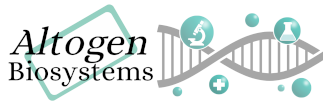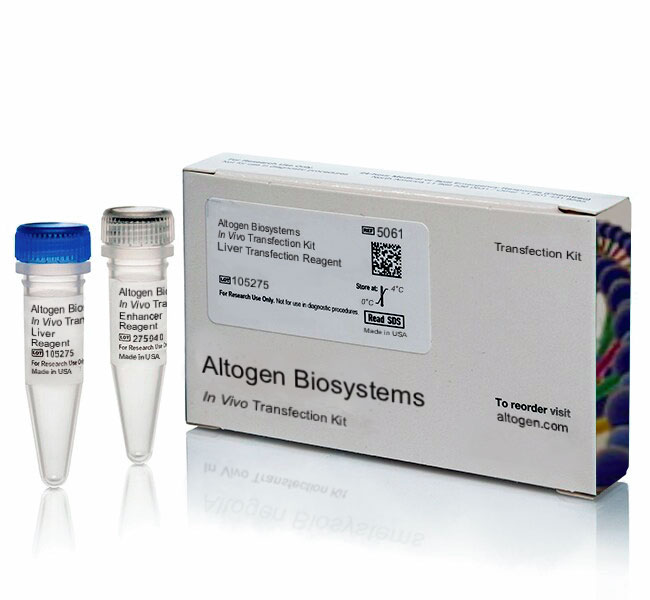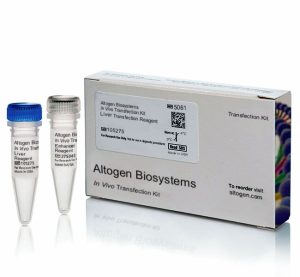Description
Purchase Orders: Click “Add to Cart” button to order, then email PO to orders@altogen.com.
Product Availability: In Stock.
Liver In Vivo Transfection Reagent
siRNA and DNA liver in vivo delivery reagent for animal research (mouse, rat)
Product Description:
This biodegradable lipid liposome-based reagent forms stable conjugated complexes for over 16 hours in serum, demonstrating efficient delivery to liver tissue and liver tumors via systemic administration (i.v..) or intratumoral injection (i.t.). It effectively delivers si/sh/miRNA, mRNA, plasmid DNA, and small proteins with minimal toxicity. The reagent has been functionally validated in laboratory rats and mice.
Liver-targeted In Vivo Transfection Reagent
- Biodegradable lipid liposome-based reagent
- Liposome conjugated complexes are stable in serum for 16 hours
- Efficient delivery to the liver tissue and liver tumors (via systemic administration or intratumoral injection)
- Efficient siRNA, shRNA, miRNA, and plasmid DNA delivery
- Minimal toxicity
- Functionally validated in laboratory rats and mice
- Applicable for plasmid DNA/siRNA co-injection
- Download Liver-targeted in vivo transfection protocol: [PDF] [Word]
- Download PowerPoint presentation for Liver-targeted in vivo transfection kit: [PPT]
- Download safety data sheet: [PDF]
- UPC/GTIN/EAN: 860002089711
-
Brand: ALTOGEN®, developed and manufactured by Altogen Biosystems
Modes of administration:
- Systemic intravenous (i.v.) injection
- Direct intratumoral (i.t.) injection
- Intraperitoneal (i.p.) injection
DATA
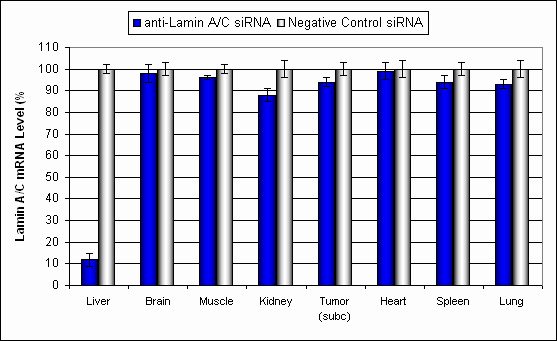
Figure 1. Systemic administration (i.v.) of Liver In Vivo Transfection Reagent conjugated with 80 ug of chemically modified siRNA targeting Lamin A/C mRNA or non-silencing control siRNA following the recommended protocol. Tissues (Liver, Brain, Muscle, Kidney, Tumor, Heart, Spleen, Lung) were collected and RNA isolated 24 hours after first injection. Samples were analyzed by qRT-PCR for Lamin A/C gene expression levels. Ribosomal RNA levels were used to normalize the Lamin A/C data. Data are means ± SD (n=6).

Figure 2. Intratumoral administration (i.t.) of Liver In Vivo Transfection Reagent conjugated with 80 ug of chemically modified siRNA targeting Lamin A/C mRNA or non-silencing control siRNA following the recommended protocol. Animal model is NOD/SCID xenograft mouse bearing flank tumor of human origin (liver cancer cell line). Tissues (Liver, Brain, Muscle, Kidney, Tumor, Heart, Spleen, Lung) were collected and RNA isolated 24 hours after first injection. Samples were analyzed by qRT-PCR for Lamin A/C gene expression levels. Ribosomal RNA levels were used to normalize the Lamin A/C data. Data are means ± SD (n=6).
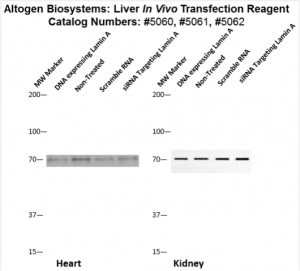
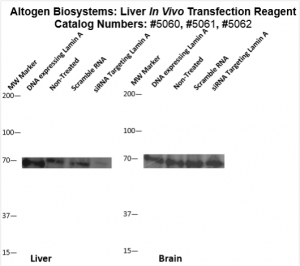
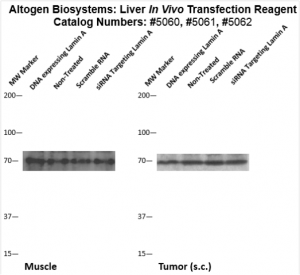
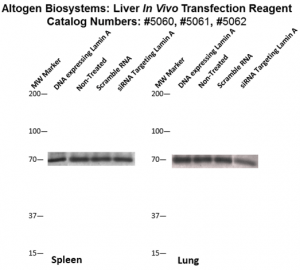
Figure 3. Systemic administration (i.v.) of Liver In Vivo Transfection Reagent conjugated with 80 ug of chemically modified siRNA targeting Lamin A/C mRNA or non-silencing control siRNA following the recommended protocol. Tissues (Liver, Brain, Muscle, Kidney, Tumor, Heart, Spleen, Lung) were collected and total protein fraction isolated 72 hours after first injection. Samples were analyzed by Western Blot Analysis for Lamin A/C gene expression levels.
Selected Liver In Vivo Transfection Reagent citations:
- Molecular Therapy Nucleic Acids. 2017. Reverse Expression of Aging-Associated Molecules through Transfection … Kim H. et al [PDF]
- PLoS Pathog. 2014 10(10) Exosomes from hepatitis C infected patients transmit HCV … Bukong et al [PDF]
- Hypertension. 2012 59(1):158-66. Role of uncoupled endothelial nitric oxide synthase … Gao et al [PDF]
- Jounal of Biological Chemistry. 2012 287(4):2907. Chaperoning of mutant p53 protein … Gogna et al [PDF]
- J Proteome Res. 2012(11) Retinal proteome analysis in a mouse model of oxygen-induced … Kim et al [PDF]
- J Transl Med. 2010 15;8:133. Prevention of hyperglycemia-induced myocardial apoptosis … Zhang et al [PDF]
Liver-targeted transfection and effective delivery
There are several strategies for achieving liver-targeted delivery, including targeting liver cells by using a liver-specific promoter to drive gene expression, which can be incorporated into the plasmid DNA or RNA construct. Another method uses delivery vehicles like modified polymers or lipids with ligands that bind to liver cell receptors for specific uptake. Additionally, viral vectors like adeno-associated virus (AAV) can naturally target liver cells and be engineered to express specific genes. Despite these methods, efficient and targeted liver transfection remains challenging due to the liver’s complexity and diversity of cell types.
Altogen’s biodegradable liver-targeted reagent forms stable conjugated complexes, demonstrating efficient delivery to liver tissue and tumors. Liver-targeted transfection reagent effectively delivers DNA, RNA, and small proteins into liver cells with minimal cytotoxicity. This reagent was functionally validated in mice and rats for targeted gene delivery. The ability to maintain stability in serum for over 16 hours ensures that the therapeutic agents reach liver cells efficiently, minimizing degradation and loss of efficacy. Targeting liver tissue and tumors is particularly significant due to the prevalence of liver diseases and cancers, providing a more focused and effective treatment option. The reagent’s efficient delivery of various genetic materials, including siRNA, shRNA, miRNA, and plasmid DNA, offers broad therapeutic potential, enabling the modulation of gene expression and correction of genetic disorders. The minimal toxicity observed in animal models addresses a major concern in gene therapy, promoting safer clinical applications. Altogen Liver In Vivo Transfection Reagent offers advanced delivery system that optimized for the specificity and efficiency of liver-targeted delivery.
Volume Options:
- 0.5 ml – 10 injections (Catalog #5060)
- 1.5 ml – 30 injections (Catalog #5061)
- 8.0 ml – 160 injections (Catalog #5062)
- 25 ml – 50 rat injections or 500 mouse injections (Catalog #5063)
Purchase Orders: Click “Add to Cart” button to order, then email PO to orders@altogen.com.
Product Availability: In Stock.
